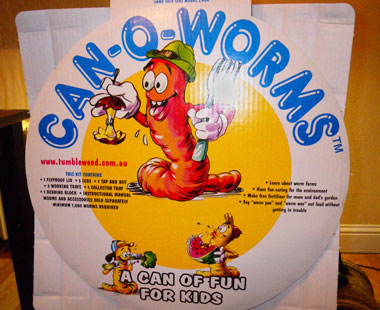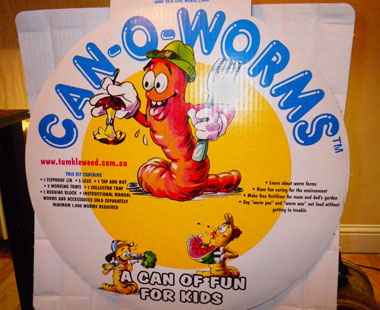 Greenie Pig opens a Can O’ Worms.Elisabeth Kwak-Hefferan has turned her apartment and daily existence into a not-especially grand experiment in green living. And she wants you to come along. Read the whole Greenie Pig series here.
Greenie Pig opens a Can O’ Worms.Elisabeth Kwak-Hefferan has turned her apartment and daily existence into a not-especially grand experiment in green living. And she wants you to come along. Read the whole Greenie Pig series here.
First off: I think composting is the bee’s knees. What’s not to love about transforming organic waste into garden steroids, and diverting trash from the landfill stream to boot? So in theory, I’m way into composting. But in reality, well, I’ve been lazy at best. I’m full of excuses: I don’t have a garden, or time/space for a bin, or the mechanical skills to build anything more complicated than a paper airplane.
All that changed when I moved to the green-lifestyle candyland of Boulder, Colo., where I had home compost pickup. How lucky was that? With only the barest effort on my part, my old avocado peels and carrot tops were magically whisked away to provide sustenance for someone else’s garden. I didn’t have to tend a bin, and because I stored food waste in the freezer until compost day, I didn’t have to smell it, either. No fuss, no muss. Even when I moved to comparatively less progressive Denver, I had my boyfriend smuggle our compost back to B-Town during his carpool to work. Perfect.
Then we moved to a Seattle apartment without this perk. (Seattle does have home compost pickup — just not for our building. But that’s fodder for another post.) I became wracked with guilt every time I tossed coffee grounds in the trash. Having tasted the wonder of composting, I couldn’t go back. But as apartment-dwellers without a garden, what could we do?
We got worms.
One thousand Eisenia fetida (redworms to you and me) to be exact. I also got one plastic worm bin — a two-tiered, cylindrical high rise — for my new tenants. The whole shebang is known as vermicomposting: You bury your organic kitchen waste in the worm bin, the worms have a feeding frenzy, and you’re left with all-natural Miracle-Gro in the form of worm castings (a rather sanitized term for what the stuff really is: poop). Not only do I get all the benefits of composting, but my inner 8-year-old is delighted by all the worm wrangling to be done. Of course, there’s still the question of what to do with the castings, being gardenless and all, but we’ll cross that bridge when we get to it.
I went with a popular commercial worm bin called the Can O’ Worms for several reasons. It’s about two feet tall and compact (perfect for my small kitchen), very simple to use (it’s got several vertical tiers for trays, making the vermicompost harvest easy), and much quicker to get going. For worms, I used a mail-order outfit called Uncle Jim’s Worm Farm (though I now know I could have found local wrigglers here in Seattle — lesson learned). I could hardly tame my excitement on the day my worm bin arrived.
To my great amusement, the Can O’ Worms is marketed not to eco-conscious greenies, but to their offspring. The bin’s cardboard box proudly announced that it contained “a can of fun for kids!” And while environmental friendliness was noted in passing, the bin boasted several other selling points: educational (“learn about worm farms”), economical (“make free fertilizer for mum and dad’s garden”), and slightly bizarre (“say ‘worm wee’ out loud without getting in trouble”).
In short order, I assembled the bin and pressed the box into the bottom of the working tray to serve as initial bedding. On top of that went the bulk of the bedding, made from a brick of coconut fiber that I rehydrated in a small plastic trash can. Smooth sailing so far. Now it was time to add the worms.
The little guys came in a surprisingly small bag of peat moss, severely dried out to survive their adventure through the U.S. mail. Uncle Jim enclosed a note warning me that the worms would look kinda dead on arrival, but not to worry: A cup of water would get them moving, and they should be back to their old selves in a day or so.
I opened the bag gingerly, and saw Uncle Jim was right: These wrigglers were languishing in their peat, too listless to move. But when I poured some water over the bedding, they instantly sprang to life, writhing like a snake pit in Indiana Jones. I scooped the worms into their new home, where they slowly uncoiled and burrowed into the coconut fibers.
I bid them goodnight and left the kitchen light on. My literature warned of a phenomenon called “worm run”: It seems that worms sometimes freak out when placed in new environment and squirm for it, slithering across the floor in a doomed flight that ends badly for everyone.
While I will tolerate a lot, I will not have mass worm suicides in my kitchen.
I’m happy to report that the worm bin is now fully operational. Stay tuned for reports on how the feeding and compost harvesting goes. I’m keen to prevent over- and under-feeding, stanky odors, and maggot invasions — plus any other common vermicompost mishaps. Tips are welcomed.




